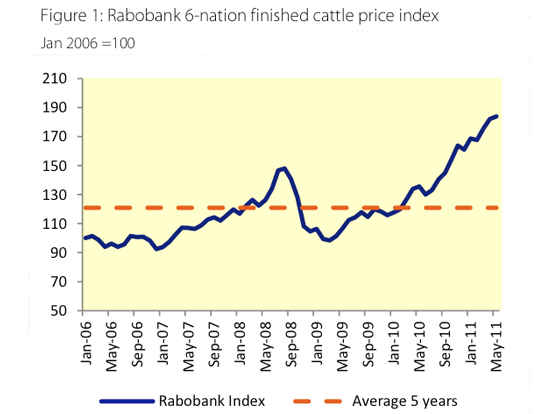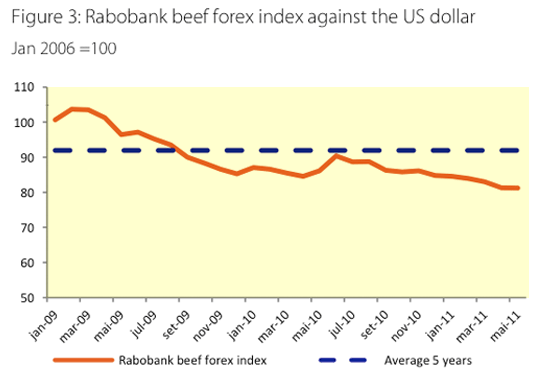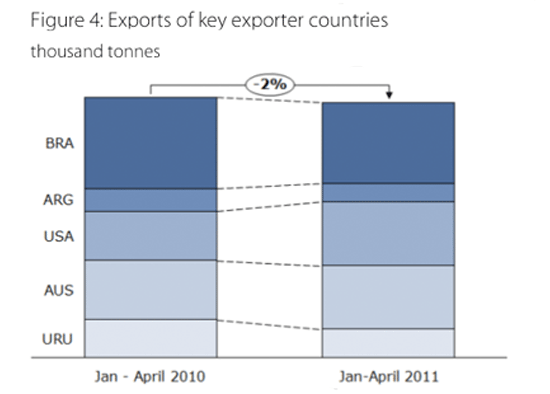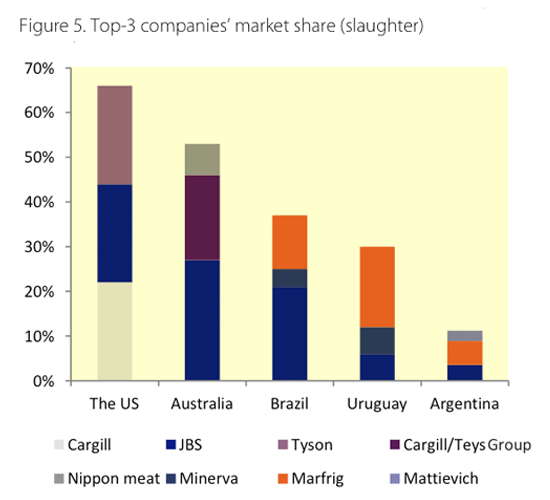



Beef Outlook - Cattle Supplies Remain Tight
Tight cattle supplies will continue to push global beef prices higher, according to the Rabobank Beef Quarterly Outlook.Global overview
Tight cattle supplies carrying prices higher globally
Finished cattle availability is still tight throughout the world as a result of cattle herd rebuilding taking place in many important producing countries after years of cow liquidation and sustained unprofitability in grain-fed markets. Although we saw a slight seasonal increase in supply in a few regions in June, the Rabobank 6-nation finished cattle price index increased by 7 per cent in Q2 2011 over Q1 2011 and stands 38 per cent above the same quarter in 2010 (see Figures 1 and 2).
The tsunami and earthquake in Japan
These natural disasters had a significant impact on the Japanese beef markets in recent months. Local production was drastically reduced due to a combination of livestock losses and disruption to markets. While demand was also impacted for a period, it is expected to recover much more quickly than local production. In contrast, imported beef sales volumes and prices increased.
Emergence of the US as a net beef exporter
The US has turned a net export of beef this year due to a lower US dollar, robust global demand driven by supply challenges in Japan and Korea and contracting imports as the lower US dollar makes alternative markets more attractive for traditional US suppliers such as Australia, New Zealand and Canada. The trend is expected to continue throughout 2011.
Softening demand in the US/EU a concern
After impressive GDP growth in Q1 2011 of 0.8 per cent over Q1 2010 — from 1995 to 2010 the euro area’s average quarterly GDP growth was 0.41 per cent — it is natural to expect a slowdown going forward. Renewed concerns in the euro area over fiscal difficulties in Greece and other periphery members have seen consumer confidence dampened in recent months. High gasoline prices and anaemic growth are also dampening US demand prospects just as demand seemed to be gathering momentum early in the year. Unemployment has again crept over 9 per cent in May, and fears of a double dip in the US housing market have dampened consumer confidence in June.

Source: Rabobank, 2011
Figure 2: Global average live cattle prices
| Live cattle prices (USD/kg) | % 2Q11 | % 2Q11 | |||
|---|---|---|---|---|---|
| Countries | Q2 2011 | Q1 2011 | Q2 2010 | x 1Q11 | x 2Q10 |
| Uruguay | 2.10 | 1.88 | 1.41 | 12% | 49% |
| Australia | 2.30 | 2.07 | 1.60 | 11% | 44% |
| Brazil | 2.25 | 2.18 | 1.59 | 3% | 42% |
| US | 2.63 | 2.36 | 2.11 | 11% | 25% |
| Argentina | 1.87 | 1.85 | 1.39 | 1% | 34% |
| Canada | 2.70 | 2.66 | 2.01 | 2% | 34% |
| Source: Bloomberg, USDA, MLA, CEPEA, INAC, IPCVA, OCA, 2011 | |||||

Source: Rabobank, 2011

Macro policy tightening slowing demand growth in emerging markets
Authorities in both Brazil and China have actively intervened in recent months in an effort to slow their overheating economies and dampen the inflation that is threatening to break out. CPI growth is running at over 6 per cent annualised in Brazil and in China. Importantly, food inflation is higher in both countries, motivating authorities to intervene to dampen politically sensitive food price inflation.
Persistent US dollar weakness in Q2 2011
This has been particularly so when compared to the currencies of key beef-trading nations. The US dollar has fallen 4 per cent this year against the Rabobank forex beef basket, further encouraging US exports, discouraging imports and supporting US dollar beef and cattle prices (see Figures 3 and 4).
Industry comments
Beef processing consolidation to ramp up
As processing capacity structurally moves ahead of cattle availability globally due to the decline in global beef cattle inventories, one important likely consequence is a renewed wave of industry consolidation and rationalisation in primary beef processing. With the ever-increasing need to build a global platform to source and trade beef products and other animal proteins, the next era of successful beef processors will need the size and reach to both access the cattle they need as well as arbitrage the trading opportunities that are increasingly present in the global beef industry.
While the industry in the US has been highly consolidated for many years, and plant numbers have been steadily rationalised, much of the industry in the rest of the world remains highly fragmented. Brazil has seen a period of rapid consolidation in recent times to the point that now it has developed companies with the size and scale to become global champions in the beef industry as well as the strength to diversify out of beef into other animal protein species such as pork, poultry and lamb.
Competition between beef-packing companies for cattle has become fierce and has forced cattle prices higher than would be the case were supply and processing capacity in better alignment. There is nothing new in this, but the challenge for beef packers under these circumstances has become more complicated. Another important challenge beef processors face in this environment is financial liquidity for working capital in the face of extremely high cattle prices. Therefore, larger companies with a greater access to finance from a variety of sources have a competitive advantage over smaller players, which are sometimes forced to simply reduce their throughput levels owing to their limited liquidity. As a result, we see a weakening in the position of middle-tier processors unless they have a special niche position that affords margin protection. The rest are at the mercy of higher prices and more volatile markets, paving the way for further rationalisation in global beef processing.
This trend has been particularly evident in recent times in Brazil, with a number of mid-tier beef processors going bankrupt. In the state of Mato Grosso alone, which is responsible for 12 per cent of the total Brazil cattle herd, 17 of the 40 beef packing plants are closed. In Argentina, several plants have closed in the past year (or are closed temporarily) as a result of this squeeze.
Across the Pacific, the situation is not as severe. However, we see the continued march of consolidation in that market also, with the larger end of the market driving the change. Following on from JBS’ acquisition of Rockdale beef in Australia last year, which took them to 28 per cent of the national slaughter, a response by one of the other majors seemed logical and timely.
The recently announced joint venture (JV) between Cargill and Teys Group is a logical response. Prior to this JV, Teys Group and Cargill had 13 per cent and 6 per cent of the Australian slaughter, respectively. Furthermore, as the Australian cattle herd continues its inexorable migration north, Cargill found itself without plants in the key production region of South and Central Queensland. The Teys Group tie-up remedies this problem for Cargill and gives them more flexibility to service both domestic customers, like the largest retailer Woolworths, and changing global markets. The JV will now account for some 19 per cent of the national slaughter, making it the clear number two in the Australian market and in possession of a management team steeped in the Australian beef cattle industry.
Access to Cargill’s global network and AAA balance sheet is likely to have been compelling for the domestic, privately held Teys Group. The deal makes the Australian beef industry one of the most consolidated in the sector, with the market share of its top- 3 companies at 55 per cent (see Figure 5).

Global Update
Brazil
- The supply of finished cattle started in 2011 is still suffering from the cattle herd rebuilding process and the severe weather impacts caused by the La Niña effect in the second half of 2010.
- However, the market observed a slight improvement in the supply of finished cattle towards the end of Q2 due to seasonally colder and dryer weather.
- Fresh beef exports during Q2 2011 have been significantly lower in volume than in Q1 2011 and Q1 2010 as a consequence of the ongoing appreciation of the Brazilian real coupled with the still high cattle prices, which have cut down the profitability of exports.
- During the first five months of the year, beef exports by volume were 15 per cent lower than 2010.
Domestic wholesale beef prices slipped slightly in Q2 2011, pushed down by declining pork and poultry prices along with fears of a slowdown of the Brazilian economy as GDP growth estimates for 2011 were revised lower to 3.8 per cent in June. - Finished cattle numbers are expected to tighten seasonally into Q3 2011 as a result of the colder and dry weather in the Southeast and Centre West regions. Relief could come from the increase in the number of animals finished in feedlots, which may not happen due to the current high feeder cattle and feed prices.
- Given tight supplies, the strong Brazilian real and herd rebuilding underway, margins on international sales are likely to remain under pressure. An increase in such margins, which could boost Brazilian exports, would require
- a strong devaluation of the Brazilian real;
- ii) a decrease in live cattle prices, which is unlikely given the anticipated tight supply conditions, or
- iii) a sharp increase in export prices, which is also unlikely in light of the expected general tightening of monetary policy as a tool to curb inflation.
- Domestic consumption, on the other hand, is expected to continue holding up well and may absorb part of the production that would be exported. However, the space for a further significant rise in beef prices is limited.
The US
- With the increase in the number of cattle on feed — as a consequence of herd liquidation due largely to drought deteriorating pasture conditions and high grain prices — and the trend towards higher weights, total beef production increased 2 per cent in Q2 2011 over the previous quarter and 0.2 per cent in comparison with Q2 2010.
- Even as beef production increased, prices remained strong: well above 2010 and 2009 levels. Cutout prices were on average 5 per cent higher than in Q1 2011and 25 per cent higher than the same quarter last year.
- Supporting the strength in prices is the continued strong export demand pushed by the increase in sales to the Korean and Japanese markets. Additional tailwinds for exports have been the weaker US dollar, which depreciated 4 per cent against the Rabobank forex index since the beginning of the year. During the first four months of 2011, US exports were up 30 per cent over the same period in the year before.
- Further supporting the domestic market is the contraction in imports, which has declined 17 per cent from the beginning the year to April in comparison with the same period last year. The weaker US dollar was a major factor explaining this reduction.
- During the first part of the year, prices were also supported by the continued recovery of the US economy.
- With economic growth apparently slowing and unemployment stuck at high levels, third quarter fed cattle prices are projected to be flat. With the potential softening of domestic demand, packers are not expected to be able to turn flat fed-cattle prices into higher profit levels.
- Placements in May were 11 per cent below year-ago levels. Accelerated placements during the first part of the year drew down feeder cattle numbers, leaving supplies tight for the remainder of the year. This, along with high corn prices, will continue to pressure feedlot margins.
- The industry is not entering an expansion phase; rather, the calf crop during the second half of the year is projected to contract for the fifth straight year.
EU
- EU beef production increased slightly during Q2 2011 in spite of the current low margins faced by producers. The major factor behind this rise was increased cow disposals.
- Exports from the region remained strong to all main destinations, motivated by the opening of the Turkish market and the shortage from other suppliers. Between January and March, exports were up 180 per cent over the same period last year.
- Imports, however, continued to decline as a result of a combination between short supply from South America and an unfavourable exchange rate. Total imports during the first three months of the year were 20 per cent lower YOY. Given this combination of lower production and increasing net exports, EU beef prices continued their upward trend, with Q2 2011 prices up 4.2 per cent over Q1 2011 and 10.5 per cent YOY.
- Demand has remained under pressure due to the continued negative effects of the economic crisis and rising prices.
- For Q3 2011, production should remain low as a result of the higher feeding costs and increased cow slaughter in 2010 and the first half of 2011.
- Imports are also not expected to ease the beef supply scenario within Europe, given the unfavourable exchange rates and relatively tight supplies in South American countries.
- However, Rabobank expects exports will remain high due to strong demand, especially in Turkey and Russia, and the ongoing shortage from other suppliers.
- As a result, the availability of beef for local consumption should be lower, which is likely to support beef prices. Coupled with a slower pace of economic growth, this should continue to put pressure on local consumption. EU beef consumption is expected to fall 1 per cent in 2011.
Australia
- After reaching record levels in the first quarter, cattle prices in Australia have rapidly declined during the second quarter, with heavy steers down from AUD 3.50 per kilogramme at the end of March to AUD 3.00 per kilogramme by late June.
- There have been a number of factors behind the decline. The first is seasonalality; supply of cattle increases in northern Australia as the rainy season ends and mustering can begin. Another factor has been the subdued demand out of Japan, which has been impacted by the tsunami and strong competition from the US. The Korean and Russian markets, which provided strong demand in the first quarter, have also seen a slowing in sales as importers look to reduce some of the large stocks of beef purchased earlier in the year. The Australian dollar is also putting significant pressure on export returns, with the currency at record levels against the US dollar.
- The Australian government’s suspension of live cattle exports to Indonesia in June — following reports of mistreatment of Australian cattle in Indonesian processing plants — also brought further challenges to cattle producers. Fortunately, the ban lasted less than a month, and from now on exports will occur under the condition that international standards for animal welfare are met. Compliance with these standards is subject to independent audit.
- Cattle prices will likely remain under pressure for much of the third quarter, before seeing some improvement towards the end of the quarter as Russia and Korea once again begin to buy increased volumes as current stock levels decline.
Argentina
- In the past few years, the cattle sector in Argentina went through a process of herd reduction. This process peaked in 2009, with record slaughter numbers and a high proportion of females sent to slaughter. Since then, slaughter has dropped dramatically as the cycle of herd retention begun, and this translated into lower production, lower exports and higher prices for beef in 2010 and 2011.
- Slaughter was down 18 per cent YOY in Q1 2011, and continued decreasing in the month of April, with a 17 per cent YOY reduction, and reaching a 30-year minimum. Female cattle participation for the first four months of 2011 averaged 39.1 per cent, the lowest in the last 22 years.
- As a result, slaughterhouses were operating at only 40 per cent of installed capacity and several plants were temporarily or permanently closed.
- Exports from Argentina remain at historically low levels, with monthly averages of 20,000 tonnes for the first four months of 2011. This represents a 19 per cent YOY reduction, and a 47 per cent reduction in comparison to Q1 2009. In US dollar terms, exports rose 12 per cent YOY in the first four months of 2011 as a result of higher international prices.
- Despite the population’s appetite for beef, the sharp increase in retail prices seen in the past 15 months has curbed consumption from an average of 69 kilogrammes per capita in 2009 to 58 kilogrammes per capita in 2010, to 51.6 kilogrammes per capita during the first four months of 2011 (annualised basis). This reduction in consumption is in spite of a strong growth in GDP.
- For the coming months, we expect slightly increased supply due to seasonality, but still at lower levels than last year. Indeed, meat packers are likely to continue to operate well below capacity as result of the lower slaughter, which is not expected to begin to pick up again until 2012, given that the entire process of herd rebuilding could take up to five years. The industry is currently negotiating some sort of support from the government to weather this downturn, but nothing has come out of those negotiations so far.
China
- China’s beef production continued to experience a serious beef supply shortage in Q2 2011 as a consequence of the ongoing cattle herd liquidation, which has been accelerated by the current high production costs. As a result, beef cattle prices increased 5 per cent YOY during the first five months of 2011, though the price level has been high since 2008.
- Both imports and exports have increased in the first four months of 2011. Imports reached 5,210 tonnes, up 16 per cent over the same period in 2010, while exports were 7,318 tonnes, up 26 per cent.
- The shortage of beef supply will continue over Q3 2011 as a result of the rising cost of corn and other feed inputs and the ongoing structural herd liquidation.
- The beef supply shortage, combined with the projected economic growth (which should support the Chinese appetite for beef despite the fact that beef is not the favourite meat), will keep beef prices at the current high level.
- China is expected to further increase beef imports to cover the domestic supply gap. China has become a net beef importer if we include the bulk shipments via grey channels. Imports are mainly supplied by Uruguay, Australia, New Zealand and Brazil.
Other countries
Uruguay- Supply of beef in Uruguay has decreased in Q2 2011 in comparison with the year before. This decline is the result of the reduced stock in 2010, which is recovering gradually following the drought.
- The number of animals slaughtered over Q2 2011 is estimated to be 13 per cent lower, and the average weight of cow and finished cattle killed — in carcass terms — were 2 per cent and 1 per cent lower, respectively, YOY.
- As a consequence, the exported volume continued to dropping, with sales declining 24 per cent between January and April — on a YOY basis — despite the buoyant demand for Uruguayan beef. However, revenues in US dollars went up 2 per cent, supported by the strong international prices. The main destinations for Uruguayan beef are still Russia, the EU and NAFTA, which together accounted for 68 per cent of the amount sold.
- For the rest of Q3 2011, Rabobank expects Uruguayan exports will continue to be under pressure given the cow retention, which should put pressure on beef production, and reduced stocks of finished animals.
- The discovery of foot-and-mouth disease (FMD) in Korea in 2010 has had a significant impact on the local livestock sector, including cattle. The outbreak has resulted in the culling of around 150,000 head over the past six months, which accounts for near 10 per cent of the total beef cow herd. In addition, the prolonged and widespread nature of the outbreak impacted onsumer confidence in beef and resulted in disruptions to local cattle slaughter, which fell 14 per cent in the first quarter of the year compared to 2010, before recovering from April as FMD was brought under control and markets were reopened.
- The pressures on local supply from FMD saw a sharp rise in beef imports, with sales from both Australia and the US increasing rapidly during the first quarter of the year to reach 75,000 tonnes in the first quarter — with a peak of 36,000 tonnes in March alone — this compares with just over 50,000 tonnes for the entire first quarter last year.
- The surge in imported beef demand early in the year has been followed by an easing in sales in the second quarter, with importers looking to reduce some of the beef stocks which have now built up. Beef sales to the Korean market should pick up from July, as buyers prepare for the high beef consumption festival of Thanksgiving, to be held in late September.
- The tsunami and resultant nuclear leaks have significantly impacted Japanese beef markets in recent months.
- Local production, which generally makes up around 40 per cent of total supply, fell 6 per cent in March due to a combination of livestock losses and disruption to markets. In contrast, imported beef sales volumes and prices increased off the back of decreased local supply and consumer concerns regarding the safety of local product.
- The US has increased its sales to Japan significantly in the wake of the tsunami, with the relatively low US dollar supporting exports.
- After an expected low in seasonal beef consumption late in the second quarter as Japan enters the rainy season, demand should increase once more in the third quarter.
Outlook
For Q3 2011, global beef supply should remain tight due to ongoing herd rebuilding in Brazil, Argentina, Australia and Uruguay, coupled with the seasonal dryness in key countries and high grain prices globally. This should also affect production in regions such as the EU and the US.
Overall demand should remain firm over the coming months. However, the current challenging macroeconomic scenario in the US and the EU, along with the recent tightening monetary policy undertaken in many emerging countries, could cool down consumers’ willingness to pay more for beef.
Moreover, given the current high beef prices, an additional significant increase may trigger substitution with other meats.
Rabobank concludes that beef prices around the world will remain firm in the midterm, although a further significant increase could trigger substitution with other meats.


